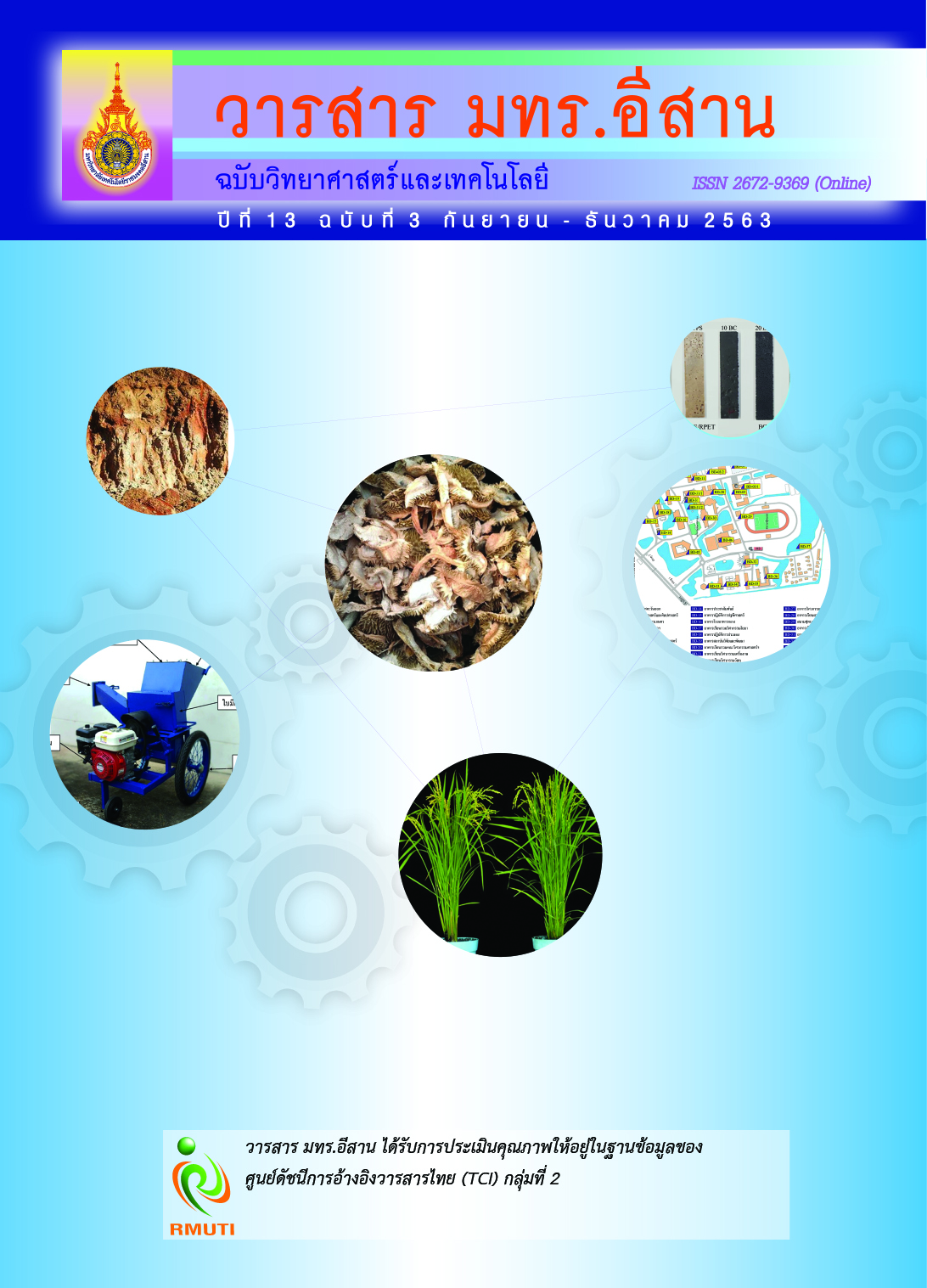Hydrogen Production from Aluminium–Water Reactions: Thermodynamic Properties Analysis
Main Article Content
บทคัดย่อ
Hydrogen production from low price materials at moderated temperature should be developed for sustainable commercial production. The aluminium and water reaction at low temperature is very attractive because it can generate hydrogen without a reactor operating at high temperature and pressure required. The hydrogen production process by hydrolysis reactions of aluminium with NaOH in different types of water was studied. It was aimed at better understanding on how the Cl ions in different types of water affect the hydrolysis at the different reactions for the hydrogen production. It was observed that the ionic strength of the solutions strongly increased with the Cl ions and aluminium mass added. However, simultaneous effect resulted in the coefficient of lower hydroxide ions (OH-) activities. The activities of the hydroxide ions at the employed conditions of the reactions were calculated using Aspen PlusTM. NaOH additives dissolved in water, produced hydroxyl ions and consequently promoted the hydrolysis reactions between aluminium and water. The maximum hydrogen generated was 583 ml as obtained from the reaction of 1 g aluminium in 30 ml distilled water for 30 min.
Article Details
เอกสารอ้างอิง
Yavor, Y., Goroshin, S., Bergthorson, J. M., Frost, D. L., Stowe, R., and Ringuette, S. (2003). Enhanced Hydrogen Generation from Aluminum-Water Reactions. International Journal of Hydrogen Energy. Vol. 38, Issue 35, pp. 14992-15002. DOI: 10.1016/j.ijhydene.2013.09.070
Belitskus, D. (1970). Reaction of Aluminum with Sodium Hydroxide Solution as a Source of Hydrogen. Journal of the Electrochemical Society. Vol. 117, Number 8, pp. 1097-1099
Wang, H.-W., Chung, H.-W., Teng, H.-T., and Cao, G. (2011). Generation of Hydrogen from Aluminum and Water-Effect of Metal Oxide Nanocrystals and Water Wuality. International Journal of Hydrogen Energy. Vol. 36, Issue 23, pp. 15136-15144. DOI: 10.1016/j.ijhydene.2011.08.077
Hiraki, T., Takeuchi, M., Hisa, M., and Akiyama, T. (2005). Hydrogen Production from Waste Aluminum at Different Temperatures, with LCA. Materials Transactions. Vol. 46, Issue 5, pp. 1052-1057. DOI: 10.2320/matertrans.46.1052
Elitzur, S., Rosenband, V., and Gany, A. (2014). Study of Hydrogen Production and Storage Based on Aluminum-Water Reaction. International Journal of Hydrogen Energy. Vol. 39, Issue 12, pp. 6328-6334. DOI: 10.1016/j.ijhydene.2014.02.037
Rosenband, V. and Gany, A. (2010). Application of Activated Aluminum Powder for Generation of Hydrogen from Water. International Journal of Hydrogen Energy. Vol. 35, Issue 20, pp. 10898-10904. DOI: 10.1016/j.ijhydene.2010.07.019
Macanás, J., Soler, L., Candela, A. M., Muñoz, M., and Casado, J. (2011). Hydrogen Generation by Aluminum Corrosion in Aqueous Alkaline Solutions of Inorganic Promoters: the Alhidrox Process. Energy. Vol. 36, Issue 5, pp. 2493-2501. DOI: 10.1016/j.energy.2011.01.041
Hongsiri, W., Danon, B., and Jong, W. D. (2014). Kinetic Study on the Dilute Acidic Dehydration of Pentoses Toward Furfural in Seawater. Industrial & Engineering Chemistry Research. Vol. 53, Issue 13, pp. 5455-5463. DOI: 10.1021/ie404374y
Phung, K. K., Sethupathi, S., and Piao, C. S. (2018). Production of H2 from Aluminium/Water Reaction and its Potential for CO2 Methanation. In IOP Conference Series: Earth and Environmental Science. Vol. 140, p. 012020. DOI: 10.1088/1755-1315/140/1/012020
Parker, J. J. and Baldi, A. L. (2009). Composition and Process for the Displacement of Hydrogen from Water Under Standard Temperature and Pressure Conditions. United States, Patent Application Publication. Sheet 26 of 32.
Scatterday, J. W. (1974). Reefs and Associated Assemblages Off Bonaire, Netherlands Antilles, and Their Bearing on Pleistocene and Recent Reef Models. In Proceedings of the Second International Coral Reef Symposium. The Great Barrier Reef Committee, Brisbane, Australia. Vol. 2, pp. 85-106
Russo, M. F., Li, R., Mench, M., and Van Duin, A. C. T. (2011). Molecular Dynamic Simulation of Aluminum-Water Reactions Using the Reaxff Reactive Force Field. International Journal of Hydrogen Energy. Vol. 36, Issue 10, pp. 5828-5835. DOI: 10.1016/j.ijhydene.2011.02.035
Chen, C.-C. and Song, Y. (2004). Generalized Electrolyte-NRTL Model for Mixed-Solvent Electrolyte Systems. AIChE Journal. Vol. 50, Issue 8, pp. 1928-1941. DOI: 10.1002/aic.10151
Que, H., Song, Y., and Chen, C.-C. (2011). Thermodynamic Modeling of the Sulfuric Acid-Water-Sulfur Trioxide System with the Symmetric Electrolyte NRTL Model. Journal of Chemical & Engineering Data. Vol. 56, Issue 4, pp. 963-977. DOI: 10.1021/je100930y
Chen, C.-C., Britt, H. I., Boston, J. I., and Evans, L. B. (1979). Extension and Application of the Pitzer Equation for Vapor-Liquid Equilibrium of Aqueous Electrolyte Systems with Molecular Solutes. AIChE Journal. Vol. 25, Issue 5, pp. 820-831. DOI: 10.1002/aic.690250510
Kamal, I. M. and Al‐Malah, (2016). Physical Property Methods and Models. Aspen Tech, Version 10. John Wiley & Sons
Amendola, S. C., Sharp-Goldman, S. L., Janjua, M. S., Spencer, N. C., Kelly, M. T., Petillo, P. J., and Binder, M. (2000). A Safe, Portable, Hydrogen Gas Generator Using Aqueous Borohydride Solution and Ru Catalyst. International Journal of Hydrogen Energy. Vol. 25, pp. 969-975. DOI: 10.1016/S0360-3199(00)00021-5
Wang, H., Chang, Y., Dong, S., Lei, Z., Zhu, Q., Luo, P., and Xie, Z. (2013). Investigation on Hydrogen Production Using Multicomponent Aluminum Alloys at Mild Conditions and Its Mechanism. International Journal of Hydrogen Energy. Vol. 38, Issue 3, pp. 1236-1243. DOI: 10.1016/j.ijhydene.2012.11.034
Wang, H., Lu, J., Dong, S. J., Chang, Y., Fu, Y. G., and Luo, P. (2014). Preparation and Hydrolysis of Aluminum Based Composites for Hydrogen Production in Pure Water. Materials Transactions. Vol. 55, Issue 6, pp. 892-898. DOI: 10.2320/matertrans.M2013425
Wang, H., Wang, Z., Shi, Z., Gong, X., Cao, J., and Wang, M. (2017). Facile Hydrogen Production from Al-Water Reaction Promoted by Choline Hydroxide. Energy. Vol. 131, pp. 98-105. DOI: 10.1016/j.energy.2017.05.031
Huang, X., Gao, T., Pan, X., Wei, D., Lv, C., Qin, L., and Huang, Y. (2013). A Review: Feasibility of Hydrogen Generation from the Reaction Between Aluminum and Water for Fuel Cell Applications. Journal of Power Sources. Vol. 229, pp. 133-140. DOI: 10.1016/j.jpowsour.2012.12.016
Wang, H., Leung, D., Leung, M., and Ni, M. (2009). A Review on Hydrogen Production Using Aluminum and Aluminum Alloys. Renewable and Sustainable Energy Reviews. Vol. 13, Issue 4, pp. 845-853. DOI: 10.1016/j.rser.2008.02.009
Zou, H., Chen, S., Zhao, Z., and Lin, W. (2013). Hydrogen Production by Hydrolysis of Aluminum. Journal of Alloys and Compounds. Vol. 578, pp. 380-384, 2013. DOI: 10.1016/j.jallcom.2013.06.016


